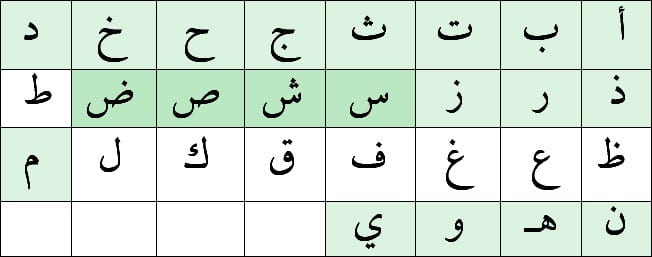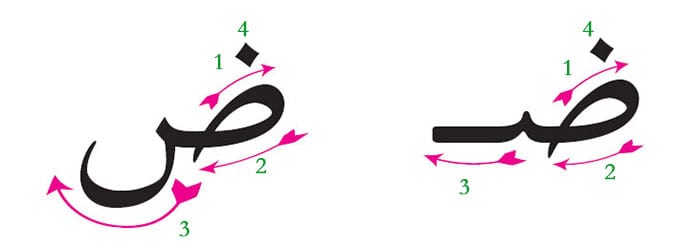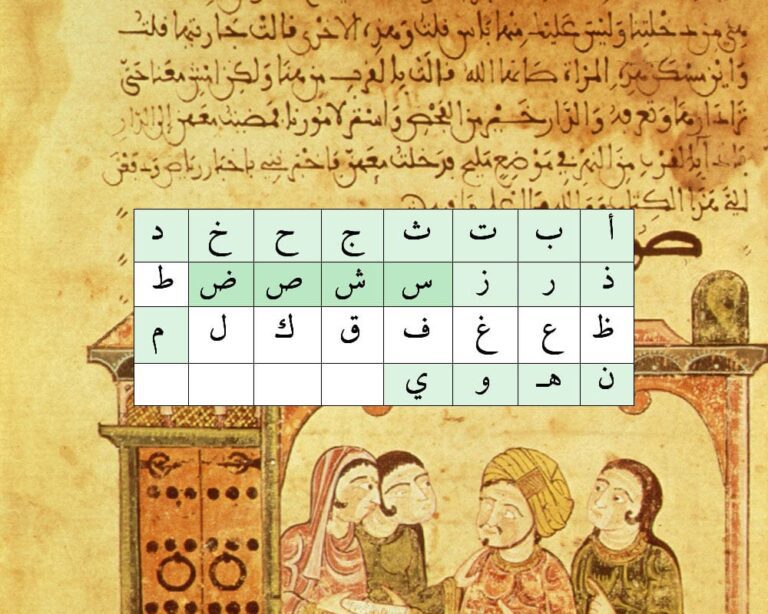Today, we limit ourselves to four letters, which are relatively easy to pronounce and write. A short lesson to take the edge off!
We’re going to discover more letters that are specific to Arabic, letters that are called ‘guttural’, because they are pronounced from the back of the throat, and with a lot of pressure. There are no examples in French or English, so you’ll have to listen, listen and repeat.
But can you see how our letter board is filling up? We’re slowing down a bit, so that we don’t run out of time to learn words, and we’ve got more and more coloured boxes!

The first two letters are very easy to pronounce, but the last two, as I said, are very specific to Arabic, so listen carefully to the video!
The س : Sin
This letter S has three ‘teeth’, two small ones and one very large one, which rises above the line. It’s a completely upside-down capital ‘M’… It is drawn by hand exactly as it is printed, and is very easy to pronounce.
When you write it, be careful to round off the last ‘tooth’, and to make it the right size, to respect the aesthetics of this very pretty letter.

Another very important thing is to draw the connecting line on the left, with the next letter.
It’s like when an m and an n follow each other, we used to tell you at school to keep them separate and not to make a ‘centipede’.
with all the letters we saw in the first lesson can easily get mixed up, so make sure you separate them.
The ش : shin
It’s the same as , but with three dots on top. The three dots mark ‘whistling’ sounds (remember Tha, still in the first lesson).
Apart from that, there’s no particular difficulty (except for people who lisp, but that’s not an Arabic problem).

The ص : Sâd
Sâd has a very rounded beginning, ending in a point, a small tooth that rises, and a large rounded tooth, like the and . It is pronounced by taking the S sound from the back of the throat. That’s why it’s called ‘guttural’. It is therefore very different from le and du, the other two sibilants in the Arabic alphabet.

What’s really important, if you want to write it correctly, is to mark the tiny tooth correctly – you mustn’t make a straight line and a rounded one.
And above all, when you tie it, you must make the connecting line, raise your hand and start the loop on the left.
The ض : Dâd
and our second guttural. Listen to it carefully in the words that follow, to pronounce the guttural D correctly. It’s also called ‘emphatic’.

Here’s how to draw it correctly (and therefore also draw the Sâd).

New words
Thanks to س and ش , we’re going to be able to form lots of new words…
شمس
The sun. Remember this word, because it’s used a lot in Arabic grammar. That’s right! Once we’ve learnt all our letters, we’ll have to separate them into lunar and solar letters. So you can guess straight away that and are solar letters!
صبر
Patience, a word much used in Arab countries. Apart from when you’re behind the wheel of a car, patience is considered to be a great quality. !
حسان
A very common first name, Hassan!
مديبة
This word means ‘city’. And it’s also the name of the city of Medina, in Saudi Arabia… quite simply ‘the city’. You can hear it here preceded by the post ‘Al’, ‘the’.
أب و أم
Two very small words, but we continue with the family. In the second lesson we discovered the son, إبت , here is the father, ‘Ab’ and the mother ‘Oum’.
and
There are at least two singers called ‘Oum’: Oum Kalthoum, whose name we’ll soon be able to spell, and ‘Oum’, a Moroccan singer. And to keep you immersed in Arabic on a daily basis, check out her Youtube channel.
شجرة
The tree, you can listen to the pronunciation if you can’t make it out: As with مديبة there’s a little letter at the end that we haven’t seen yet: ة . It’s the ‘ta marbouta’, it’s pronounced ‘a’ for now that’s all there is to know!
إنسان
Insan, man, in the sense of human being. There’s a very pretty song for children, which says ‘I am a human being, and I have a nose, eyes, a mouth’, and with each word, we touch the body part that is named. And also a song by Nass El Ghiwane whose title you can now decipher: يا بني إنسان Difficult? No, not really, the يا reads ‘Ya’, then we have بني , bani (the plural of ben, so ‘the sons’ ) and إنسان and that means? ‘The sons of man’ so human beings!
صبي
it’s the boy, as opposed to the girl ( بنت , cf. first lesson)
سيارة
… the car, the one behind the wheel of which you should be صبر , patient!
حيواب
‘Haywan’, the animal. Since we’re learning إنسان . And you can see that both words end the same way!
 A typo or syntax error? You can select the text and hit Ctrl+Enter to send us a message. Thank you! If this post interested you, maybe you can also leave a comment. We'd love to exchange with you !
A typo or syntax error? You can select the text and hit Ctrl+Enter to send us a message. Thank you! If this post interested you, maybe you can also leave a comment. We'd love to exchange with you !




